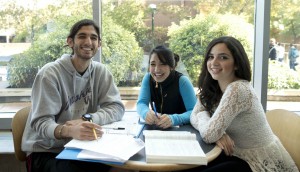 Robert Lee is more than halfway to earning a transfer associate’s degree and on track to enter a university – and he’s still in high school.
Robert Lee is more than halfway to earning a transfer associate’s degree and on track to enter a university – and he’s still in high school.
Lee is one of 1,593 Running Start students taking tuition-free classes at Bellevue College (BC). Now in its 20th year, Running Start provides up to two years (six quarters) of paid tuition at any of Washington’s community and technical colleges or public universities for 11th and 12th grade students. The Running Start students receive credit for classes just like it does for any college student.
By participating in Running Start, students can get a head start on their college education, decrease the amount of time spent in school, and make a smoother transition to college and reduce educational costs. Many students prefer the more challenging courses colleges offer, including BC Running Start student Rashel Rafat who found high school classes easy and the coursework redundant.
The added bonus is the cost savings, as students receive both high school and college credit for these classes. Rafat and Camelia Katoozian both say the cost savings was a factor in deciding to enter the program. Rachel said, “I always hear people complaining about how stressful and hard it is for them to pay for their college classes.” Another motivator is that some high school students and their parents see how participating in Running Start now can reduce their future need for student loans.
Students are responsible for paying lab and course fees, buying their textbooks and their transportation. There is a 15 college credit limit for the free tuition each quarter, but students who wish to take more than 15 college credits, or wish to attend summer school, may pay the regular tuition rate and still receive dual credit.
Enrollment in the program at BC is up 12 percent over last year, and now accounts for about 11 percent of BC’s student body of nearly 15,000 fall quarter students. The program’s growth continues an upward trend statewide as higher education costs have escalated at the same time household incomes have stagnated or declined.

Farbod Parsa (left).
A high grade-point average isn’t required for acceptance into the program, but students must pass standardized tests and qualify for college-level reading, writing and math to make sure they are academically ready for college-level work. Successfully passing a course earns a student both high school and college credit. By participating in Running Start, students are establishing a college record. The grades they earn affect admission to a university and to an intended major. Those who pass the entrance exam may take part or all of their coursework at BC.
Running Start students can complete a substantial number of credits early toward their first two years of college credits. That results in paying fewer college credits to finish before transferring to a four-year institution. It is possible for a motivated student to earn both a high school diploma and a two-year college associate’s degree simultaneously. Some students enroll full-time as high school juniors and never take another high-school class, eventually earning an associate of arts or a technical degree in addition to a high-school diploma. More typically, they divide their time between high school and college, winding up with a year’s college credit or several college courses.
Students can select courses from the entire college catalog, providing that they have met any prerequisites that the college requires of all students. The credits earned help meet high school requirements, and they also go on the student’s permanent academic transcript and can count toward a college or university degree.
Lee is aiming for a transfer degree and hopes to finish all the required classes by end of spring quarter. “But if not,” Lee says, “then I will just have my credits transferred to the university where I expect to attend this coming fall. I plan to become a doctor and will pursue being a general practitioner. With 10 years of college ahead of me, getting courses out of the way now is an important time and money saver.”
Students and parents strongly support the program because it expands their education choices, presents an academically challenging option for qualified students, while reducing the time and expense of completing their education. Washington families saved close to $42.2 million last year using the Running Start program, according to the Washington State Board for Community and Technical Colleges Running Start Annual Progress Report, 2011-12. For example, if a student wanted to attend Whitman College in Walla Walla, a private school, they could save about $43,150, the rate posted on the Whitman website for one year’s tuition. (www.whitman.edu/offices-and-services/financial-aid/costs)
“My motivation to be a Running Start student was to find out what being a college student feels like while I am still in high school and also, while getting college credits early. Another motivation was that when I took an AP class at my high school, I thought that it wasn’t as motivating nor was it fun just sitting in the same class every day, said Robert. “Running Start gave me another advantage, which was experiencing courses that obviously didn’t exist in high school, like medical courses, much more vigorous mathematics and science courses, and much more.”
It is important that students see an academic advisor to create an academic plan to be sure they take the classes needed for the transfer degree. Colleges have specific courses required for various majors, so if students have already decided on a college major, BC advisors have information on the most popular majors and can work those requirements into the academic plan. It is always best that students acquire the latest information from their college of choice as early as possible.
-by Sharon Berg
Running Start students at BC in Academic Year 2012-13
Students’ Age
- 16 Years old or less – 6%
- 17-18 Years old – 88%
- 19-20 Years old – 5%
Gender
- Female – 54%
- Male – 46%
Race/Ethnicity
- American Indian/Alaska Native – 1%
- Asian/Pacific Islander – 13%
- Black – 2%
- Hispanic – 4%
- Other – 4%
- White – 44%
- Unknown – 32%
Source: ARICA: TRAN_TRAN_STU_D, TRAN_TRAN_YRQ_D
Running Start creates an alternative way for students to transition to college. Running Start and other dual-credit programs provide post-secondary schooling for students whose options may otherwise be limited. For high school students, Running Start is one of the most readily available and cost saving entry to college-level learning opportunities in the state.
Quote from the Office of the Superintendent
of Public Instruction Website
Last Updated October 3, 2016
